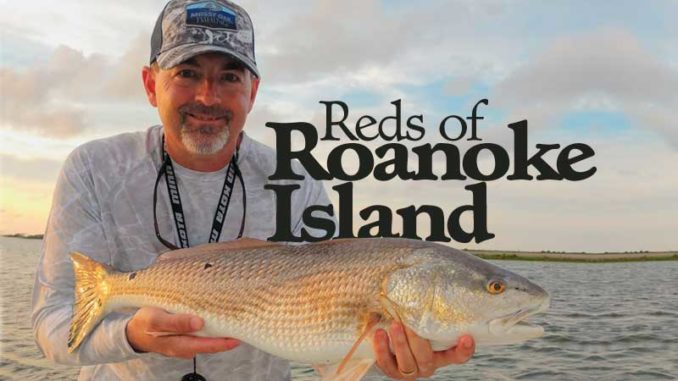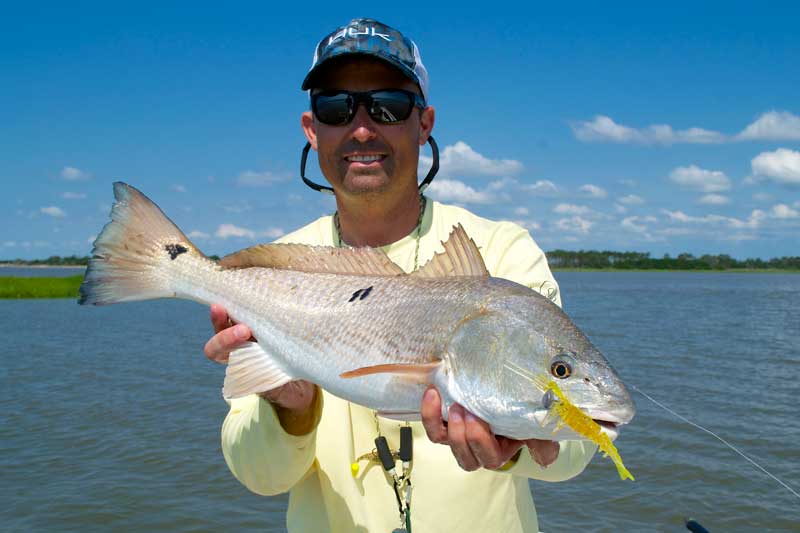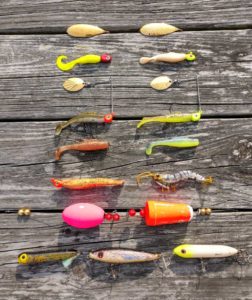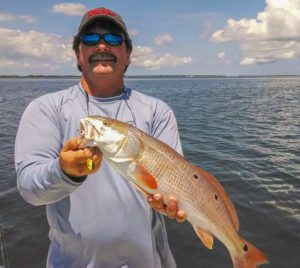
The first European settlement in North America is surrounded by waters that are home to plenty of redfish, and summer is a productive season to target them.
North Carolina doesn’t have many natural islands other than the barrier islands that line its coast. But along its northeastern coast lies one that is arguably the most-important island in the history of North America, Roanoke Island, site of the first European settlement in the “New World.”
Roanoke Island is now an important tourist vista, and it’s a special place for fishermen because of the waters that surround the 18-square mile rectangle. They offer redfish premier habitat, and summer is a perfect time to visit the waters.
The island is a bit more than 8 miles long and 2 miles wide, with typical marshes along its banks. But its location is special; it’s a bottleneck between the Albemarle and Pamlico sounds and about nine miles from Oregon Inlet, which brings clean saltwater from the ocean into inshore waters.
Guide Bryan DeHart, an Outer Banks native, has several decades of fishing under his belt in these waters.
“You can leave any boat ramp on Roanoke Island and target puppy drum a couple of different ways,” DeHart said. “You can fish the marsh edges and man-made structure around the island’s banks, or you can sight-fish the grass flats towards Oregon Inlet.”
Redfish are at home in these waters, with endless opportunities to set up and feed on small fish, shrimp and crabs. Summer conditions offer a near-perfect setup to catch as many reds as an angler wishes to catch — if he fishes the right areas with the right techniques.

The island’s banks are lined with marsh grass and numerous docks, seawalls and other man-made structure, which DeHart said holds plenty of reds during the summer.
“I like to target from the banks along the new (US 64) bridge on the west side of the island all the way to Shallowbag Bay on the east side,” he said. “There are miles of shoreline, bays, creeks and man-made structure that hold plenty of fish in the summer.”
Primarily, DeHart is looking for water depths between 18 inches and 3 feet along structure, but he’s also looking for bait, and he’ll work his way from deeper areas to the shallow stuff until he develops a pattern.
“The fish are eating small (menhaden) and shrimp in these areas,” he said. “I let the bait tell me where I need to be. If the bait is shallow, the redfish will be shallow, too.”
The typical water color and clarity in the areas around Roanoke Island might look unappealing to many anglers accustomed to fishing other coastal waters. Brown, tannic waters and a dark bottom produces poor water clarity, common conditions in this area. But the fishing can be phenomenal even when you’re forced to fish blind. DeHart relies on scented lures and lures with action in Island waters.

“I use scented lures like Gulp! on jigheads in a curlytail or paddletail, or I will use another soft plastic slathered in (scent gel),” he said. “I am a big fan of scented baits; I really believe it makes a huge difference under these conditions.”
The dark, tannic waters around the island remove any sight-casting opportunities, but for anglers willing to travel to the south, the grass flats towards Oregon Inlet can offer some unique conditions.
“It can look like the Bahamas, with hundreds of acres of submerged grass in gin-clear water,” DeHart said. “The reds will usually be a little bigger here and cruising and feeding just above the grass.”
The waters flowing in from the Atlantic through Oregon Inlet to the sand bottoms offer prime conditions to support these large beds of submerged grass species, and redfish love cruising these areas because of the abundance of baitfish and shrimp that use these grasses for a refuge.
DeHart will slide down to the grass flats to sight-fish for reds every chance he gets when conditions are ideal.
“There are certain places that are better for sight-fishing than others,” he said. “I will fish the grass flats north of the inlet on an incoming tide and the flats along the south side of the inlet on a falling tide.”
Around the inlet, DeHart turns to a ½- to ¾-ounce gold spoon as his go-to lure. It is a solid lure that will work for anglers of any skill level, and it works along the grass flats. He also likes a spinnerbait that combines a soft-plastic paddletail trailer and a gold blade to create the best of both worlds.
“These fish can see a long way, and the combination of the action of the paddletail and a gold spoon will pull these fish from a long way,” he said.
When the water is clear of floating debris, he will also use a popping cork with 8 inches of leader to a jighead and soft-plastic trailer. In low-light conditions, he will always have a topwater plug tied on.
“I love topwater fishing, and it can be incredible over the grass beds early in the morning,” he said.
The waters surrounding Roanoke Island create a unique opportunity for the redfish angler. From the murky waters surrounding the man-made structures just outside of Manteo to the crystal clear flats at Oregon Inlet, Island anglers can find plenty of solid opportunities to catch a limit of redfish under the hot, summer sun.

Wind-driven vs. tidal-driven water
Most anglers along the Atlantic coast are accustomed to lunar tides, where the water rises and falls several times during a 24-hour period, with the fluctuation as much as 4 to 6 feet.
But many of the waters in estuaries around Roanoke Island, especially those away from Oregon Inlet, lack lunar tidal changes. Instead, anglers pay attention to wind-driven tides.
Wind tides play a big factor in guide Bryan DeHart’s fishing plans.
“If the wind blows out of the northeast for a few days, the water will get real low, and the fish will pull off the banks on submerged points, irregular bottom and deeper grass beds,” DeHart said. “The opposite can happen when the wind is pushing water up on the banks. I prefer a normal level when possible, but we have to monitor the prevailing winds to make a decision where we fish and how we fish.”
DeHart will often switch to fishing live or cut bait when the waters get stacked up on the banks and pushes bait into those areas. The accompanying smells, sights and sound draw reds. Live mullet or shrimp under a popping cork can be deadly under these conditions.
DESTINATION INFORMATION
WHERE TO GO — The waters around the fringes of Roanoke Island and the western side of Bodie Island are prime summer redfish spots. Look for man-made structures, including groins, docks, sea walls and rocks. Grass beds on the north and south side of Oregon Inlet offer prime places to sight-fish for summer reds. Concentrate on the flats north of the Inlet on the incoming tide and the flats on the south end on a falling tide.
HOW TO GET THERE — Roanoke Island is the main point of access between the mainland and North Carolina’s Outer Banks; it is close to the Albemarle, Croatan and Roanoke sounds. US 64 is the main route to the island from points inland, although US 158 and US 264 provide access from points north and south. Public boat ramps are available in Manteo, Wanchese, Manns Harbor and Oregon Inlet. Visit www.outer-banks.com/publicboatramps.asp.
WHEN TO GO — Depending on water temperature, summer fishing for redfish begins in June and continues into September. Concentrate on early morning and late-evening hours for topwater fishing.
BEST TECHNIQUES — Redfish feed on small fish, crabs and shrimp around Roanoke Island, and traditional jighead and soft-plastic combinations are good choices, especially scented baits. Gold spoons in 1/2- to 3/4-ounce sizes are solid lures, along with spinnerbaits, especially around grass beds. A soft-plastic bait or live bait fished below a popping cork is productive. Live mullet, cut shrimp or cut crab will also draw redfish. Medium- to medium-heavy spinning gear is preferred, with reels spooled with braided line and fluorocarbon leaders. Rods need to be 61/2- to 7-foot for long casts often needed.
FISHING INFO/GUIDES — Bryan DeHart, 252-473-8632. See also Guides and Charters in Classifieds.
ACCOMMODATIONS — Scarborough Inn, Manteo, 252-473-3979; Outer Banks Visitors Bureau, 877-629-4386, www.outerbanks.org.
MAPS — Capt. Segull’s Nautical Charts, 888-473-4855, www.captainsegullcharts.com; GMCO’s Chartbook of North Carolina, 888-420-6277, www.gmcomaps.com.


